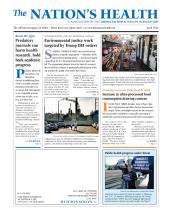
Predatory journals can mimic real publications. Study authors can help ensure they are not being duped by doing their research.
Photo by Liubomyr Vorona, courtesy iStockphoto
Public health researchers can build their careers by publishing their work in scientific journals. But many researchers are not aware that what appears to be a reputable journal online may be fake, or at best, low-brow fare.
Publishing in what are known as predatory or “pseudo” journals can damage reputations, impact career goals and result in a well-researched study missing its target, journal publishing experts say.
“They can’t re-submit them anywhere else because now they’ve been published by these illegitimate spaces, and no legitimate journal is going to touch that manuscript,” said Brian Selzer, APHA’s director of publication services, which includes APHA’s American Journal of Public Health.
The academic publishing world is largely driven by “publish or perish.” Gaining prestige and fast-track promotion at a university or college typically requires publishing often in peer-reviewed journals and having the work cited by other researchers. Publishing work in a fake or predatory journal upends that trajectory.
Predatory journals are in business to collect fees paid by authors to get their work published, with no regard for the quality of the paper. Papers usually undergo no revisions and are not peer reviewed. About 15,000 predatory journals are currently operating online, according to Cabells, a subscription-service database.
“We do see ourselves losing good research just because people are being tricked into submitting to a predatory journal,” said Stephanie Kinnan, MEth, council member of the Committee of Publication Ethics and senior managing editor at the American Society for Gastrointestinal Endoscopy.
The practice is becoming more sophisticated. AI is helping predators build slick journal websites, write legitimate-sounding solicitations and compose acceptance letters that are fooling both new and veteran researchers. A 2022 global survey in Learned Publishing of nearly 2,000 researchers found that 22% were fooled into publishing work in a bad-faith journal. Over 80% of them said they did so because they were unaware such journals existed.
If the internet was an inviting marketplace for predatory journals, the rise of open access threw open the gates. Predatory journals grew out of presses that published anything for a fee. They took off in the 2010s when more academic journals changed their business model from paywall subscription to open access, in which content is available without requiring users have a password.
While author fees for article-processing charges apply to most academic journals, open-access publications usually charge higher fees, from a few hundred dollars to thousands of dollars. Reputable open-access journals offer rigorous peer review and editorial services while generally reaching a wider audience than subscription-based journals.
Predatory journals mimic legitimate open-access sites and usually charge lower fees, but lie about sending papers through editorial services and peer review and have no archiving policy. Researchers can be fooled because publishing fees have become common for academic journals.
“It’s pretty typical now for there to be author fees associated with any published article,” Kinnan told The Nation’s Health. “When somebody’s submitting an article and they see that they’re going to be charged a certain amount, that’s not a red flag anymore.”
Many predatory journals originate in South Asian countries, such as India, Pakistan and the Philippines. A study in BMJ Open in 2019 found that about 40% of researchers falling prey were initially drawn in by a phishing email, which typically mentions seeing prior studies of the researcher and inviting submission.
In December 2022, staff at APHA’s AJPH were contacted by a researcher who claimed the journal had accepted his paper, Selzer said. The author said he had paid a publication fee and wondered when the paper would be published.
Unfortunately, the researcher had been duped: the acceptance was false. Selzer noted there were signs that could have tipped off the author, such as that it was signed by a former editor-in-chief.
“Those groups try to replicate your journal as closely as possible,” Selzer told The Nation’s Health. “We lose out on a quality paper and the researcher loses out on recognition.”
Researchers in low-and middle-income countries are more likely to fall prey to predators, the Learned Publishing global survey found. Many of the institutions are on a budget, and faculty, accustomed to economy, may be less suspicious of a site with an unprofessional presentation.
Early-career researchers are also susceptible to deception, including those in the U.S., Kinnan said.
“They haven’t been around long enough to make the connections with other colleagues who can give them information about potential predatory journals,” she told The Nation’s Health.
Scholarship can suffer when papers are published with no peer review, but also when bad actors with an agenda publish. A shady anti-vaccination study, for example, can seem more credible because it was published in a journal, albeit a fraudulent one.
“You are creating mistrust in the literature when (articles) get out there that can be harmful or can guide incorrect practices,” Kinnan said.
Avoiding online predatory journals
As a council member of the Committee of Publication Ethics, Kinnan vets potential journals for membership. She meticulously inspects journal websites for legitimacy — checking social media links, verifying contact information and physical addresses, and inspecting the scholarship of posted papers.
Kinnan also cautions that peer review takes weeks or months, so a journal claiming to do it in days should be viewed with suspicion.
Higher education libraries, which vet academic journals for authenticity and content, are sound resources for scholars seeking respectable academic journals.
Building a case for a bogus journal can be as simple as copying and pasting a journal’s physical address into Google Maps and watching it come up in a park or industrial complex, said Ruth Bueter, MLIS, associate director of library operations at the George Washington University.
Researchers need to be informed shoppers when looking where to publish, Bueter said. She advised knowing who the reputable academic journal publishers are, such as Elsevier, Sage, Springer, Taylor & Francis and Wiley. For publishers that are not as familiar, authors should do their research.
Several indexes of reputable journals are available online. Along with Cabells, two other helpful journal databases are Clarivate’s Web of Science, covering 21,000 peer-reviewed journals, and Elsevier’s Scopus, covering 27,000 peer-reviewed journals.
Also available are federally funded bibliographic databases, such as Medline and PubMed Central. But because they list journals publishing research from federally funded grants, predatory journals can slip onto the listings, Bueter said.
“When in doubt, contact your librarian and let us help you dig and figure things out,” she said.
For more information, visit www.publicationethics.org.
10 tips for spotting predatory journals
Predatory online journals are getting harder to differentiate from legitimate academic ones.
To help guard researchers from publishing in a bad-faith journal, Think Check Submit, a campaign by a coalition of scientific publishers, offers indicators that a journal site might be predatory. Such journals may:
Lack a publisher address or contact information
Advertise very fast times from submission to publication
Publish out-of-scope articles
Lack clear ownership information
Have poor or non-existent editing of articles, such as many spelling mistakes or very poor grammar
Hide information on charges
Lack an editorial board, or have an editorial board with deceased members
Lack information on peer review, licensing and copyright
Send researchers numerous emails inviting submissions, often unrelated to expertise
Falsely claim they are indexed by major services such as PubMed or the Directory of Open Access Journals
For more information, visit https://thinkchecksubmit.org/journals.
- Copyright The Nation’s Health, American Public Health Association









